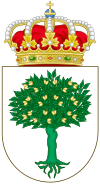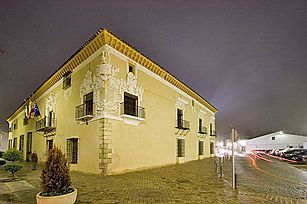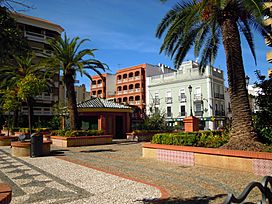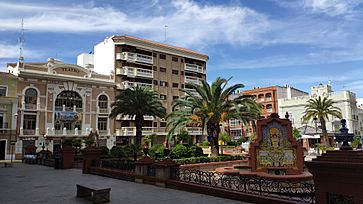Almendralejo facts for kids
Quick facts for kids
Almendralejo
|
|||
|---|---|---|---|
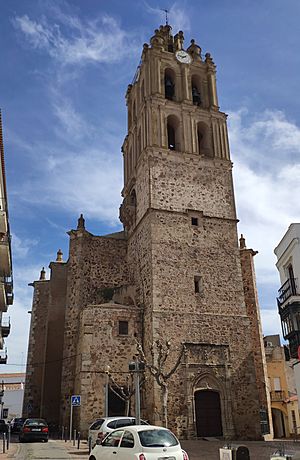
Church of the Purification
|
|||
|
|||
| Country | |||
| Autonomous community | |||
| Province | |||
| Comarca | Tierra de Barros | ||
| Area | |||
| • Total | 164.5 km2 (63.5 sq mi) | ||
| Elevation | 337 m (1,106 ft) | ||
| Population
(2018)
|
|||
| • Total | 33,468 | ||
| • Density | 203.45/km2 (526.94/sq mi) | ||
| Demonym(s) | Almendralejenses | ||
| Time zone | UTC+1 (CET) | ||
| • Summer (DST) | UTC+2 (CEST) | ||
| Postal code |
06200
|
||
| Official language(s) | Spanish | ||
Almendralejo is a town in the Province of Badajoz, which is part of the Extremadura region in Spain. It is located about 45 kilometers (28 miles) southeast of the city of Badajoz. The town is on a major road and rail route. This route connects Mérida and Seville. As of 2010, Almendralejo had a population of 33,975 people. It was also the location of an important historical event in 1936 during the Spanish Civil War.
Contents
History of Almendralejo
Ancient Discoveries
A very special silver plate was found in Almendralejo. It is called the Missorium of Theodosius I. This plate is a great example of ancient Roman art. Finding it here suggests that an important Roman site was once nearby.
Early Engineering: The Albero de Ferria
In 1747, a large dam called the "Albero de ferria" was built in Almendralejo. It was one of the first big dams to use water power. The dam was 122 meters (400 feet) long and 19.5 meters (64 feet) high. It was made of strong stone and had supports to make it even stronger. Some parts of the dam even had a mill inside, making it unique. This was the first dam to have a water wheel built right into its structure.
Growth and Trade
In the late 1800s and early 1900s, Almendralejo became an important trading center. It was known for trading grain, fruit, and wine. The Mérida-Los Rosales railway helped with this trade. The town also held a big yearly sheep fair.
Modern History
In 1936, a significant historical event took place in Almendralejo during the Spanish Civil War.
Geography of Almendralejo
Almendralejo is about 45 kilometers (28 miles) southeast of Badajoz. It sits on a large flat area south of the River Guadiana. The slightly higher land to the south is known as the Tierra de Barros.
Town Development
The town grew quickly in the late 1800s. This happened as new roads and railways were built. Almendralejo has wide streets and impressive buildings.
Local Economy
The economy of Almendralejo mainly focuses on farming. Farmers grow a lot of cereals, fruit, and grapes. There are many vineyards around the town. A local red wine is made here, and the area is also famous for producing brandy.
Culture and Landmarks
Important Buildings
Almendralejo has several notable historical buildings. The Church of the Purification, or Iglesia Parroquial de Nuestra Señora de la Purificación, was finished in 1515. It is built in the Gothic style. The church has a well-designed tower and a beautiful 17th-century retablo (a decorative screen behind the altar).
The Palacio del Marqués de Monsalud is another important building from the 17th century. Today, it serves as the town's council offices. The building has a central courtyard. On the ground floor, you can see arches supported by pink granite columns. The first floor has a red ceramic railing. This palace was also the birthplace of the famous poet José de Espronceda. It now holds a museum with Roman artifacts found in the area.
Famous People
Carolina Coronado (1820 – 1911) was a well-known Spanish writer. She was famous for her poetry. Many people consider her as important as other Romantic writers of her time. She also played a role in diplomacy. She used her writing to support important causes, like the abolition of slavery.
Population Data
The graph below shows how the population of Almendralejo has changed over time since 1842.

Sports in Almendralejo
Football Clubs
Almendralejo has a strong history in football. The club CF Extremadura used to represent the town. It was founded in 1924. They reached their highest point in 1996 when they were promoted to La Liga, Spain's top football league, for the first time. After being relegated, they returned to La Liga for the 1998–99 season. However, they faced financial problems and eventually closed down in 2010.
In 2007, a new football club, Extremadura UD, was started. This club continued the football tradition in the town. As of 2018, Extremadura UD played in the Segunda División, which is the second level of the Spanish football league system.
Home Stadium
The home ground for the football club is Estadio Francisco de la Hera. It has a capacity of 11,580 seats.
Gallery
See also
 In Spanish: Almendralejo para niños
In Spanish: Almendralejo para niños



